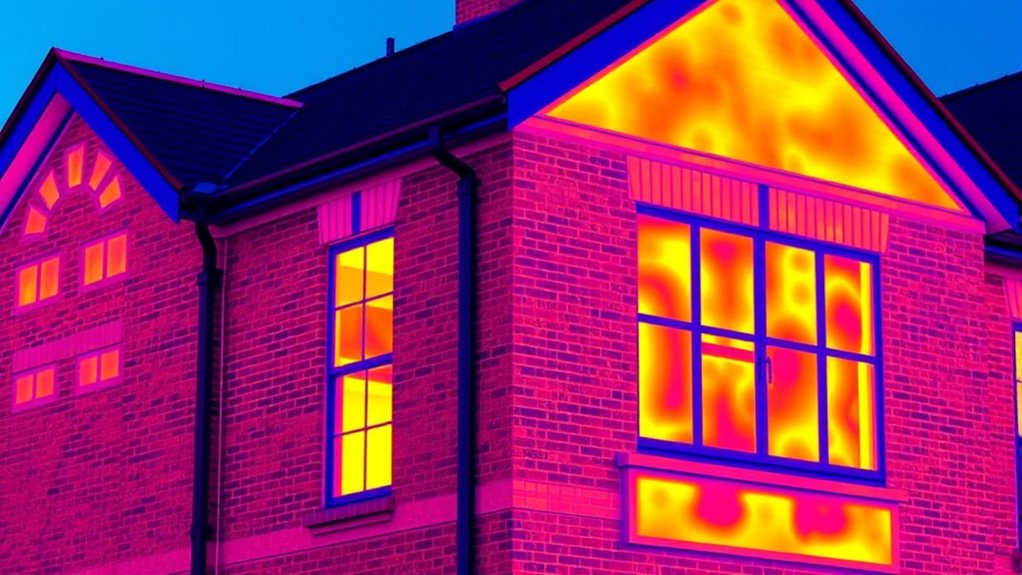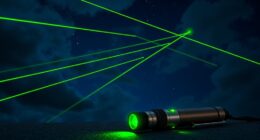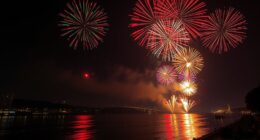Infrared thermography is a valuable tool for building inspections, allowing you to spot hidden issues like thermal bridging and moisture intrusion quickly and without any damage. It captures thermal images to reveal temperature differences on surfaces, helping you identify insulation gaps, leaks, and damp areas early. Using this technology can improve energy efficiency and prevent costly repairs. If you want to discover how infrared thermography can enhance your inspections, keep exploring the details.
Key Takeaways
- Infrared thermography provides quick, non-invasive detection of hidden issues like thermal bridging and moisture intrusion in buildings.
- It identifies temperature variations that reveal structural problems, energy losses, and moisture buildup behind surfaces.
- The technique enables early diagnosis of issues, reducing repair costs and preventing mold or structural damage.
- Infrared inspections cover large areas efficiently, minimizing occupant disruption during assessments.
- It supports proactive maintenance, enhances building energy efficiency, and promotes overall structural health.

Infrared thermography has become an essential tool in building inspections, allowing inspectors to quickly identify hidden issues that aren’t visible to the naked eye. By capturing thermal images, you can detect temperature variations across surfaces, revealing problems like thermal bridging and moisture intrusion that might otherwise go unnoticed. These issues can compromise the building’s energy efficiency and structural integrity, so early detection is crucial.
Infrared thermography quickly detects hidden issues like thermal bridging and moisture intrusion in buildings.
Thermal bridging occurs when heat bypasses insulation through more conductive materials like metal or concrete, creating localized cold spots on the building’s exterior or interior surfaces. Using infrared cameras, you can easily spot these cold spots, which indicate areas where heat is escaping. Recognizing thermal bridging helps you recommend targeted insulation improvements, reducing energy loss and lowering heating or cooling costs. It also highlights potential points of thermal stress, which could lead to material fatigue or damage over time.
Moisture detection is another vital aspect of infrared thermography. Moisture within walls, ceilings, or floors often causes temperature differences that show up as irregularities in thermal images. When moisture accumulates, it generally cools down the surface, creating distinct thermal signatures. Spotting these cold spots allows you to identify leaks, condensation buildup, or plumbing issues early. This proactive approach helps prevent costly repairs, mold growth, and structural deterioration. Since moisture problems can be hidden behind walls or beneath floors, infrared imaging provides a non-invasive way to locate these issues without unnecessary demolition.
Using infrared thermography also enhances your ability to assess the overall health of a building quickly. Instead of invasive inspections, you can scan entire structures from a safe distance, covering large areas efficiently. This method not only saves time but also minimizes disruption to occupants. As you interpret thermal images, you develop a clearer understanding of underlying issues, enabling you to advise building owners on necessary repairs or improvements. Additionally, understanding insulation effectiveness is key to improving energy efficiency and reducing utility costs.
Incorporating infrared thermography into your inspection process offers a comprehensive view of a building’s condition, especially when it comes to thermal bridging and moisture detection. It empowers you to identify problems early, often before they manifest into more significant, expensive repairs. This proactive approach ensures the building’s safety, efficiency, and longevity, making infrared thermography an indispensable part of modern inspection techniques.
Frequently Asked Questions
How Accurate Is Infrared Thermography in Detecting Hidden Moisture Issues?
You might wonder how reliable infrared accuracy is for moisture detection. Infrared thermography can effectively identify hidden moisture issues by revealing temperature differences caused by moisture presence. While it’s a powerful tool, it’s not 100% definitive. You should combine infrared inspections with other methods like moisture meters for the most accurate results. Overall, infrared thermography provides a valuable, non-invasive way to detect moisture problems early.
Can Infrared Cameras Identify Electrical Faults Before Failure Occurs?
Did you know that thermal imaging can detect electrical faults with over 85% accuracy before failure occurs? You can use infrared cameras to identify issues like overloaded circuits, loose connections, or overheating components early. By capturing temperature anomalies, thermal imaging helps prevent costly electrical failures, ensuring safety and reliability. This proactive approach allows you to address potential problems before they turn into major, expensive repairs.
What Are the Limitations of Infrared Thermography in Building Inspections?
You might wonder about the limitations of infrared thermography in building inspections. Sensor calibration is essential; if not calibrated correctly, readings can be inaccurate. Visibility constraints also affect effectiveness, especially in areas with poor insulation or obstructed views. You may struggle to detect issues in complex structures or through thick materials, making it vital to understand these limitations for reliable results.
How Does Weather Affect Infrared Thermography Results?
Weather can throw a wrench in your plans, making infrared thermography results less reliable. Variability in weather, like wind or rain, cools surfaces unevenly and affects thermal readings. Seasonal effects also play a role, causing temperature differences that mask or mimic issues. To get accurate results, you need to conduct inspections during stable weather conditions, ideally on clear, calm days when surface temperatures are consistent and less affected by outside influences.
What Training Is Required to Operate Infrared Thermography Equipment Effectively?
You need proper training to operate infrared thermography equipment effectively. This includes understanding certification standards, which guarantee you meet industry requirements, and completing hands-on training to gain practical experience. By combining theoretical knowledge with real-world application, you’ll learn how to interpret thermal images accurately and safely. This extensive training prepares you to perform inspections confidently, adhere to standards, and deliver reliable results in various conditions.
Conclusion
Infrared thermography acts like a detective’s eye, revealing hidden issues beneath the surface. By using this technology, you can identify problems early, save energy, and prevent costly repairs. Think of it as a window into your building’s hidden secrets, giving you clarity and peace of mind. Embrace this powerful tool, and you’ll transform inspections from a routine task into a proactive, insightful process—making your building healthier and more efficient, one scan at a time.









